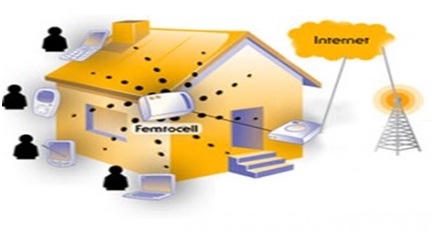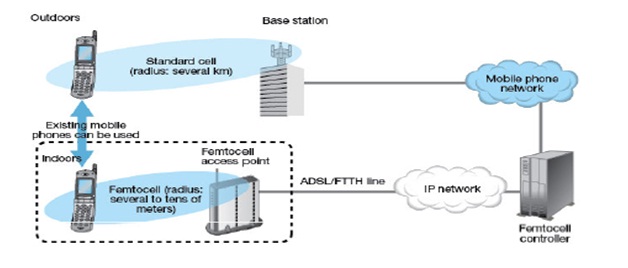





Published on Feb 14, 2025
Mobile cellular and 3G networks normally ften suffer from poor penetration and reception in certain areas, like indoors. This decreases the quality of voice and video communication and slows down high-speed services.
A femtocell is a small device that is used to improve wireless coverage over a small area, mostly indoor. It is a small cellular base station, also called a wireless access point that connects to a broadband Internet connection and broadcasts it into radio waves in its area of coverage. As a result, mobile handsets can handle phone calls through the femtocell, via the broadband Internet connection. The name femtocell has the prefix 'femto', meaning a very small cell (area of network coverage).
Small is rather a big word here, because femto denotes a division that is mathematically represented by 10 raised to the power of -15, or a quadrillionth. In plain English, it is one divided by a figure with fifteen zeros. Well, close to infinitely small. The first interest in femto cells started around 2002 when a group of engineers at Motorola were investigating possible new applications and methodologies that could be used with mobile communications. Further after 2yrs. In 2004 more attention was given to this technology and it was enhanced further. A femtocell is a small device that is used to improve wireless coverage over a small area, mostly indoor.
Third-generation cellular technology suffers from inadequate indoor-signal penetration, leading to poor coverage in the environment where consumers spend two-thirds of their time. Poor coverage diminishes the quality of voice and video applications, and slows down high-speed data services To keep customers satisfied, 3G carriers have increased capacity by building additional microcell sites. This strategy is becoming much less attractive. Site acquisition costs are exorbitant and continue to mount as space on viable towers and buildings fills up, landlords exact high rents and regulators impose onerous permit requirements. Public opposition to the building of large-scale base stations is increasingly common.

• 3G cells are smaller by virtue of supporting higher data rates
• 3G infrastructure needs to Proliferate
• Femtocells are a vehicle for expanding 3G coverage and improving indoor coverage
• Infrastructure must evolve to support millions of small cells
Third-generation cellular technology suffers from inadequate indoor-signal penetration, leading to poor coverage in the environment where consumers spend two-thirds of their time. Poor coverage diminishes the quality of voice and video applications, and slows down high-speed data services To keep customers satisfied, 3G carriers have increased capacity by building additional microcell sites. This strategy is becoming much less attractive. Site acquisition costs are exorbitant and continue to mount as space on viable towers and buildings fills up, landlords exact high rents and regulators impose onerous permit requirements. Public opposition to the building of large-scale base stations is increasingly common. Acquiring a site is only half the battle: Sophisticated base station equipment must then be purchased, installed, insured, operated and maintained. The net present value of a cell site in the U.K. is estimated to be $500,000. Carriers thus face a serious dilemma.
Well it's clear more and more consumers want to use mobile phones in the home, even when there’s a fixed line available. Friends and family usually call a mobile number first, and it’s where messages and contact lists are stored. However, it is often the case that providing full or even adequate mobile residential coverage is a significant challenge for operators. From a competitive perspective, femtocells are important because mobile operators need to seize residential minutes from fixed providers, and respond to emerging VoIP and WiFi offerings. Improving user experience in the home is also essential for reducing churn and gaining marketshare and new revenues. However, high deployment costs ensure that 3G networks rarely extend beyond the regulatory minimum.
Using femtocells solves these problems with a device that employs power and backhaul via the user’s existing resources. It also enables capacity equivalent to a full 3G network sector at very low transmit powers, dramatically increasing battery life of existing phones, without needing to introduce WiFi enabled handsets.
• Indoor cellular coverage
• Can “talk” with any handset device • Low cost backhauling
• More than 50% voice calls and more than 70% data traffic are originated indoor
• The 3Cs--coverage, churn and capacity--are stifling 3G adoption.
• Femtocells produce cost savings as well for the carriers. Consumer's home in essence becomes a cell site and there is no site acquisition costs involved.
• Electricity bills can be minimized.
• Unlimited mobile minutes for a fixed monthly fee.
The 3Cs--coverage, churn and capacity--are stifling 3G adoption. Femtocells produce cost savings as well for the carriers. Consumer's home in essence becomes a cell site and there is no site acquisition costs involved. Electricity bills can be minimized. Unlimited mobile minutes for a fixed monthly fee. The call charges can also be reduced based on which subscriber we are using. Provides better coverage and also prolonged battery life compared to others. Portable and easy to install and use.
• Indoor cellular coverage
• Can “talk” with any device
• Low cost backhauling

Femtocells from part of the mobile operation’s network, although they are located at home or in the business. Most of the functionality of a completer 3G cell site has been miniaturized onto a chip, which look and operates like a WiFi access point, and is connected via broadband DSL back to the mobile operator’s network. A femtocell is installed at home and connected to mains power and a standard broadband IP connection (typically DSL) through to the mobile operator’s core network. Voice calls, text massages and data services are provided by the same systems. Femtocells operate at very low radiation power levels (50 milliwatts peak output during a call, much lower when idle), and typically have a range of 200 meters.
The signals do not travel through walls particularly well, but this is a benefit because it allows the frequency to be reused for other calls in nearby building. Where users walk outside or out of range, calls are automatically handed over to the external mobile network. Any standard 3G phone can be used on the femtocell if permitted by the mobile operator. Unlike WiFi access points, 3G Femotcells operate using licensed spectrum and thus must be supplied and operated in conjunction with the mobile operator Figure 1 shows working of femtocell. The battle is most likely to be between the modified 3G RAN (which some RAN Network vendors are keen to promote because it reuses their existing RNC products) versus UMA, which has new, custom designed systems architected to handle the much larger number of cells and IP connectivity.
SIP based solutions may be of interest where the user wants to bypass the network operator When registered handsets enter the range of a femtocell, handing over to the femtocell network is done automatically, such that calls are channeled through the broadband connection. One femtocell can support up to 5 mobile handsets. Femtocell technology, which is another block in the Fixed-Mobile Convergence concept, is still in its early days and it is receiving fierce competition from UMA and Wi-Fi technologies. For instance, one might ask why invest in femtocells when a cheap Wi-Fi router can do the work with a Wi-Fi supporting handset, given that handsets supporting Wi-Fi are becoming more common and are being shipped by hundreds of millions.
• A Femtocell is used for compensating poor cellular coverage inside the homes – in some places.
• A Femtocell can also give lower call charges while the caller calling from home, using the Femtocell as it directly connects to the core network through the internet.
• Some vendors are also planning to incorporate all the three features – Wi-Fi, cellular and DSL into the same box to achieve maximum functionality.
• The voice calls/data calls through the Femtocells are encrypted and the cell phones automatically switches over to the Femtocells when they come in their range – eg. in homes, where they are installed.
• Femtocell units can handle up to three or four simultaneous calls, from the same operator, depending on the model. They can operate with normal cellphones, without any enhancements.
• Femtocell units can help related cellular services like 3G by offering a better speed and data rate when inside buildings, where the coverage and data rate is generally lesser than outside.
• Generally, the cell towers are back-hauled by using lines with bandwidth of around 2 Mbps (in some places) and hence when newer services like 3G are introduced, these lines may not be sufficient and hence may require a upgrade. But with Femtocells, since the subscribers internet connection is used, there may not be an issue with existing infrastructure if Femtocells are adopted in a large scale.
• Femtocells can not only extend the cellular macro network but can also become the primary network if enough Femtocells are adopted in an area. So, all future upgrades etc. can be done by the Femtocells itself, reducing the number of macro base stations required to cover an area – but this is a long shot, based on the current situation and the problems described below.
| Are you interested in this topic.Then mail to us immediately to get the full report.
email :- contactv2@gmail.com |